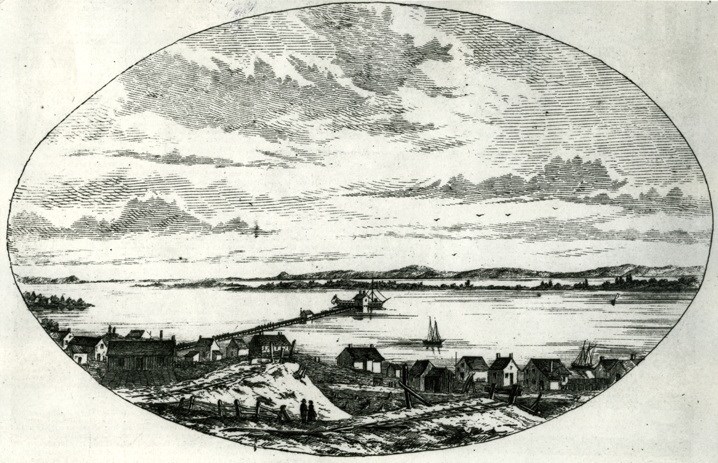From the archives of the Sault Ste. Marie Public Library:
*************************
Remember This . . . Bruce Mines – An Early Mining Town
Driving along Highway 17 East you pass through the town of Bruce Mines, but many people may not realize that it is a town with a long history.
The town’s roots can be traced back to the industry of copper mining. Samuel de Champlain recorded the existence of copper mines on his map of 1632 during the early exploration of this area. Etienne Brule is believed to have spent one winter in the area of Bruce Mines investigating the existence of the copper deposits.
Members of the First Nations tribes in the area had discovered the importance of copper as a valuable item to trade with the white men who had begun arriving in the New World.
The actual site of Bruce Mines was established as a settlement in 1842 when the first settlers came from Cornwall, England.
The origin of the name of Bruce Mines can be traced back to James Bruce Elgin, 8th Earl of Elgin who was appointed the Governor General of Canada in 1846.
John Keating, the Indian Agent, and Arthur Rankin, a land surveyor, explored this area and discovered the presence of copper and realized the potential for developing a working copper mine.
Keating approached some of the new Cornish immigrants about coming to work for him and utilizing their skills in mining. In 1846 the copper mine was opened and became the first copper mine in Canada. It would eventually become one of the most important mines in existence during the mid-1850s.
The Huron & St. Mary’s Copper Co. was established to manage the miners and the first load of ore was shipped out to Wales in 1847. During 1845 – 1846 there was a rush on applications that were made to the government for mining licenses in order to take advantage of the mining resources available in the Bruce Mines area. Two men, Joseph Woods and James Cuthbertson, were both vying to obtain mining licenses. Mr. Cuthbertson eventually purchased the property that he was interested in, which became known as the Cuthbertson Location but he sold the location almost immediately to the Montreal Mining Company.
According to the population statistics for 1848, there were about 250 people living in Bruce Mines. Records show that there were three wood frame buildings and approximately thirty log houses.
Some of these log structures were used for stores, workshops and lodging. As with any mining operation many of the residents were transitory and lived in tents due to the shortage of available housing.
At this point there were 63 people employed at the mines.
Less than a decade later Bruce Mines had doubled its population and had about 75 homes with 300 people working in the mines. The settlement now included a Methodist chapel, a public house, a store and a store house. By 1857, Bruce Mines was considered the most important town in the district with a population of 500 people while at the same time Sault Ste. Marie had a recorded population of only 400 people.
There were ten mine shafts in use and the ore was removed from the ground, crushed by the steam driven machinery before being “water-washed in puddling troughs”.
Most of the ore was then shipped out to Wales for processing which eventually became very costly.
Bruce Mines has experienced adversity throughout the years. A cholera epidemic swept through the village in 1849 and many lives were lost. It is uncertain whether the epidemic was caused by impure water or by an infected person entering the village but the only way that people were able to combat the disease was to quarantine the infected person and feed them liquids.
The area was also subject to a number of catastrophic fires. In July of 1863 a forest fire spread to the village and destroyed many of the houses leaving many people homeless. However, the people showed great resilience by rebuilding their homes and businesses before the onset of winter even though in many cases they had to wait to get supplies from other communities.
A second fire occurred in November of 1916 and then a third fire in November of 1947 destroyed much of the business district located on south side of the street.
Large sailing ships and steamers made regular stops at the port, making it a bustling community. In 1856, Bruce Mines shipped out about 598 tons of copper and about 2000 barrels of pickled fish.
Unfortunately by 1865, production of copper had declined significantly. The quality of the ore being mined in the veins began to decline and the price per pound dropped from 24 cents in 1850 down to 14 cents per pound.
As the decline in the copper mines continued, a large cave-in occurred in 1876 spelling doom for the future of the copper mines and the mines finally closed. At this point many of the miners left to find work elsewhere but the people that stayed turned to farming and lumbering instead.
Attempts were made to reopen the mines in later years but they proved to be unsuccessful.
Bruce Mines was incorporated as a town in 1903 and continues to be a town rich in history — and definitely worth a visit.
*************************
Each week, the Sault Ste. Marie Public Library and its Archives provides SooToday readers with a glimpse of the city’s past.
Find out more of what the Public Library has to offer at www.ssmpl.ca and look for more Remember This? columns here
